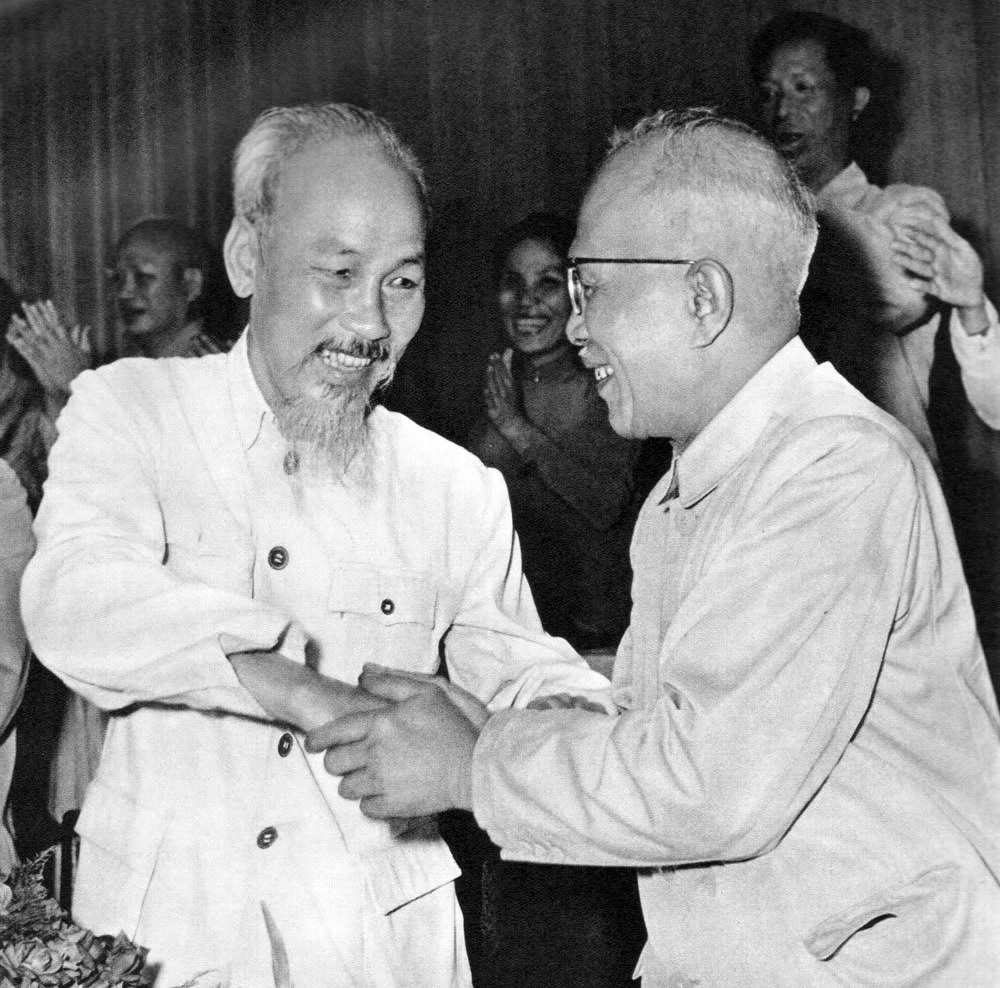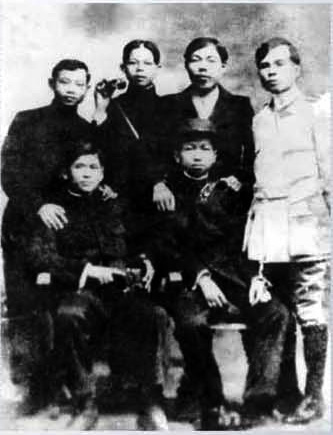President Ton Duc Thang

The indomitable tradition of this country had soon smouldered from the vindictive hatred toward the invaders, as well as the patriotism had deep down set inside the youth-Ton Duc Thang. Yet with the well conscious about life and working class he had perceived, and as such, a revolutionary and beloved leader he became as we know today.
Born in Long Xuyen, the South of Vietnam, the undaunted and hurtful piece of land that had been suffered from the French colonial invasion over 20 years, Ton Duc Thang had lived and studied in a provincial school there. After having finished the primary education, he came to Saigon, left behind his family and amity to start anindefatigable revolutionary life for his country and his people.
In 1906, Saigon warmly greeted the enthusiastic eighteen-year-old-Tôn Đức Thắng. That ‘revolutionary seed’ was planted in the very middle of Saigon, which was full of invaders then. He did choose nothing from the profitable advancing path, but the path to be the working class.
THE BIOGRAPHY OF TON DUC THANG PRESIDENT
- Code name: Thoai Son
- Born: 20/8/1888
- Died: 30/3/1980
- Nativeland: My Hoa Hung Commune, Long Xuyen City, An Giang Province
- Background: Farmer
- Party member: 1930
EMPLOYMENT HISTORY
- From 1906-1909: Studied in VienDong Industrial College, then bacome a worker in The Ba Son Shipyard –a Floatingdock constructed for French Navy, SaiGon.
- In 1912: Organised and took the lead of Ba Son’s workers’ strike.
- From 1914-1918: Carried out revolution from The World War, then became military worker in Toulon naval port ( Southern Region of France) and worked as a mechanic in France battleship.
- 20/04/1919: Under the guiding of French Labour Union, joined the objector and flew the Red flag in a battleship to support the Russian October Revolution, participated the mutiny of French soldiers in Hac Hai sea surface, expelled from France afterward.
- In 1920: Established the Secret Labour Union in SaiGon, the first Labour union of VietNam working-class.
- In 1927: Participated the VietNam Revolutionary Youth League and directly headed the SaiGon-Cho Lon Labour’s movement.
- On 12-1928: Arrested in SaiGon by the enemy.
- On 26-07-1929: Condemned 20 years in labour camp.
- In the early morning on 3/7/1930, the ship of the French- Armand Roussean left Saigon quietly and exiled Ton Duc Thang along with a number of officials, patriotic members to Con Dao. Until 18/8/1945, when Con Dao was liberated,the prisoner with the number 5289 – TF, who was noted a dangerous person, hadproved his extraordinary perseverance, determination and eternal loyalty to our “Revolution”. Spending 15 years in “the hell on earth” – Con Dao is not only the toughest time in the revolutionary life of Ton Duc Thang but also his glorious lifetime when he turned an imperial prison into a revolutionary school.
- In 1930, established the cell of the prison to lead the prisoners to fight back, recognized by the southern regional party committee to be a special person and became an adherent since then. With the experience gained in a secret union in Saigon, Ton Duc Thang along with the communistsestablished the organization of the prisoners to create a leadership, gather prisoners andcreated a united power to be against the custodial regime. Many communists included Ton Duc Thang were sentenced and detained with other prisoners at Banh I, which was especially for normal prisoners such as burglaries and thieves. This was a maneuver of the French colonialists who wanted to borrow the hands of their prisoners to kill the Communists. As an experienced man in the secret organization in Saigon, Ton DucThang discussed with these prisoners, to found the organization of Red Prisoners as the important leaders and gather them to build a secret organization to against the prison regulations. However, the guards discovered Ton DucThang when he was having a meeting with the organization and he was imprisoned at a rice warehouse. This place is such the hell, with vilolent torture to the prisoners, which is called “Khu trừng giời”. Knowing enemies’ plan, Ton DucThang gathered some Comrade communists to find ways to get power to help improve the lives and working conditions of the prisoners here such as: changing the punishment regulations to prisoner, arranging and assigning work according to their health. The weak sorted out rice or packed rice. The strong ground or transfered rice bags. Everyone would take turns to work equally.
- In 1934, after leaving the rice-hulling mill, Ton Duc Thang worked at the So Luoi factory. His duties was fixing machines and driving canoes. Since then, So Luoi has become the headquarter of the party organization in Con Dao to get contact and help officials Party prisoners to escape and come back to the mainland.
- On August 8, 1945, The Soviet Union declared itself to be in a state of war with Japan. It quickly defeated and surrendered to Soviet troops the Kwantung army which had more than a million Japanese soldiers at the time. On August 15, 1945, Japanese fascists officially surrendered to the Soviet Union and the Allies. The Party led the people in the whole country to have the general uprising in the whole country. After Ho Chi Minh’s speech of Declaration of Independence broadcasted by a foreign radio station, the islanders brust into tears of joy.
- In the morning of 23 September 1945, the PhuQuoc ship and other 25 gull boats transfered 1800 political prisoners back to the mainland. The newly renovated canoe named Giai Phong was salied by Ton DucThang himself to pick some comrades on the board to return. Despite the difficulties, everyone safely arrived at Dai Ngai pier, SocTrang province in the afternoon of September 3, 1945 with a warm welcome of the Party and local people.
- From August 1945: returned to Nam Bo, worked as a member of the South Vietnam Resistance Committee, in charge of food and weapons.
- On January 6, 1946: elected as the first National Assembly Member of the Democratic Republic of Vietnam and joined the delegation of Congress to France.
- On May 1, 1948: Ho Chi Minh president called people to join the patriotic emulation, and on June 11, 1948 officially launched the patriotic emulation movement. At this time, Ton DucThang achived got good results in helping Ho Chi Minh's thought and the policy to become the driving force of the national resistance.
- When comrade commander of the zone VIII reported to Uncle Ho about the resistance, Ton Duc Thang visited the delegation. He said although participating in the common leadership here - a great mission, he always thought of the South Vietnamese people and the Southern battlefield. He repeatedly proposed to Uncle Ho to return to the battlefield to join the comrades and the South Vietnamese compatriot but Uncle Ho refused. He asked the comrade, the delegation to report back to the Executive Committee and the reporter Nam Bo that Ton Duc Thang is the person of the South people, always thinking of the South and the country where he was born and worked. During this period, the Standing Committee of the National Assembly delegated its members to the localities in the Third and the Viet Bac inter-region to mobilize the people to resist the war and Ton Duc Thang was the head of the Committee.
- From 1951: Acted as the Acting Chairman of the Standing Committee of the National Assembly. At the Second Party Congress, chosen to be the Central Executive Committee of the Vietnam Workers' Party. He was a member of the National Assembly from the term I to VI.
- In September 1955: Elected as the head of the National Assembly Standing Committee.
- In 1960: Vice Chairman of the National Assembly, Minister of the Interior, General Inspector of the Nation, Chairman of the Standing Committee of the National Assembly, Vice President of the Democratic Republic of Vietnam (July, 1960). In September 1960; Elected as an official member of the Party Central Committee.
- From 23/9/1969 to 1981: Became the president of Vietnam socialist republic.
- On 30 March 1980: He passed away at the age of 92 in Hanoi.
Here are some pictures of Ton DucThang president:

Ho Chi Minh President congratulated Ton DucThang Uncle when he was elected to the second National Assembly

Ton Duc Thang at the Port of Toulon (France) in 1916
